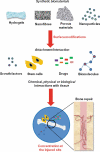Recent Advances in Biomaterials for the Treatment of Bone Defects
- PMID: 32799735
- PMCID: PMC7714479
- DOI: 10.1080/15476278.2020.1808428
Recent Advances in Biomaterials for the Treatment of Bone Defects
Abstract
Bone defects or fractures generally heal in the absence of major interventions due to the high regenerative capacity of bone tissue. However, in situations of severe/large bone defects, these orchestrated regeneration mechanisms are impaired. With advances in modern medicine, natural and synthetic bio-scaffolds from bioceramics and polymers that support bone growth have emerged and gained intense research interest. In particular, scaffolds that recapitulate the molecular cues of extracellular signals, particularly growth factors, offer potential as therapeutic bone biomaterials. The current challenges for these therapies include the ability to engineer materials that mimic the biological and mechanical properties of the real bone tissue matrix, whilst simultaneously supporting bone vascularization. In this review, we discuss the very recent innovative strategies in bone biomaterial technology, including those of endogenous biomaterials and cell/drug delivery systems that promote bone regeneration. We present our understanding of their current value and efficacy, and the future perspectives for bone regenerative medicine.
Keywords: Biomaterials; bio-scaffolds; bone regeneration; bone remodeling; regenerative medicine.
Figures


References
-
- Kohli N, Ho S, Brown SJ, Sawadkar P, Sharma V, Snow M, García-Gareta E.. Bone remodelling in vitro: where are we headed?: a review on the current understanding of physiological bone remodelling and inflammation and the strategies for testing biomaterials in vitro. Bone. 2018;110:38–46. doi:10.1016/j.bone.2018.01.015. - DOI - PubMed
Publication types
MeSH terms
Substances
LinkOut - more resources
Full Text Sources
